|
|
|
Sort Order |
|
|
|
Items / Page
|
|
|
|
|
|
|
| Srl | Item |
| 1 |
ID:
160789
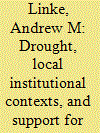

|
|
|
|
|
| Summary/Abstract |
We address two questions on the effects of climate change for social instability. First, do droughts and their associated environmental impacts affect support for the use of violence? Second, do local-level formal and informal institutions moderate support for violence when and where droughts worsen? To answer these questions, we conducted a national survey of 1,400 Kenyans in 2014. Respondents were asked about patterns of rainfall and the presence of rules regulating natural resource use and access. Survey data are joined to spatially disaggregated observed rainfall trends. The survey uses endorsement experiments to elicit honest responses about support for using violence. There is some evidence of a direct, though limited, link between observed drought and violent attitudes. Certain local-level natural resource use rules have moderating effects on support for violence where drought is reported and precipitation is less frequent. This conditional and contextual effect is an important modification of overly simplistic narratives of universal climate change effects.
|
|
|
|
|
|
|
|
|
|
|
|
|
|
|
|
| 2 |
ID:
137786
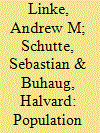

|
|
|
|
|
| Summary/Abstract |
One of the most powerful predictors of violent political conflict is proximate violence in space and time. This spatiotemporal pattern has been identified between countries as well as within them. What explains this clustering is less clear, and different studies point to different mechanisms. Focusing on sub-Saharan African states, we examine whether population attitudes may contribute to the spread of political violence at subnational scales. In a quasi-experimental research design—using georeferenced survey data of 18,508 respondents for 162 administrative units across 16 countries, paired with precisely georeferenced conflict event data—we find that popular acceptance of (the legitimacy of) the use of physical violence is positively associated with subsequent conflict events. Furthermore, the combined effect of nearby violence and approval of violence is stronger than either condition alone, implying a diffusion effect. While we find some evidence that conflict events affect later public opinion, our final models control for violence that occurred before the survey data were gathered. The fact that we include such violence in our analysis suggests that the reported results cannot be dismissed as merely reflecting a reverse causal relationship.
|
|
|
|
|
|
|
|
|
|
|
|
|
|
|
|
| 3 |
ID:
137791
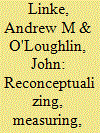

|
|
|
|
|
| Summary/Abstract |
How does political violence affect the attitudes and beliefs of affected populations? This question remains of central concern to the discipline of conflict studies. In response, we make the case (by empirical example) that the choice of spatial and temporal ranges of analysis influences conclusions about the associations between exposure to political conflict and subsequent opinions. Using 2005 survey data from Russia's North Caucasus and georeferenced conflict data for the preceding 2 years, we find that violence affects levels of ethnic pride, trust in public institutions, and preferences for ethno-territorial separation, as well as other postwar attitudes. By designating a wide range of distance and time boundaries for capturing a conflict/attitude relationship, we argue for a more inductive style of analyzing theoretical propositions than is usually found in the field of conflict research. Our research is framed within the theoretical and empirical discussions of contextual-, neighborhood-, and community-level drivers of individual-level outcomes from the political geography and conflict studies literatures.
|
|
|
|
|
|
|
|
|
|
|
|
|
|
|
|
| 4 |
ID:
152297
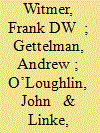

|
|
|
|
|
| Summary/Abstract |
How will local violent conflict patterns in sub-Saharan Africa evolve until the middle of the 21st century? Africa is recognized as a particularly vulnerable continent to environmental and climate change since a large portion of its population is poor and reliant on rain-fed agriculture. We use a climate-sensitive approach to model sub-Saharan African violence in the past (geolocated to the nearest settlements) and then forecast future violence using sociopolitical factors such as population size and political rights (governance), coupled with temperature anomalies. Our baseline model is calibrated using 1° gridded monthly data from 1980 to 2012 at a finer spatio-temporal resolution than existing conflict forecasts. We present multiple forecasts of violence under alternative climate change scenarios (optimistic and current global trajectories), of political rights scenarios (improvement and decline), and population projections (low and high fertility). We evaluate alternate shared socio-economic pathways (SSPs) by plotting violence forecasts over time and by detailed mapping of recent and future levels of violence by decade. The forecasts indicate that a growing population and rising temperatures will lead to higher levels of violence in sub-Saharan Africa if political rights do not improve. If political rights continue to improve at the same rate as observed over the last three decades, there is reason for optimism that overall levels of violence will hold steady or even decline in Africa, in spite of projected population increases and rising temperatures.
|
|
|
|
|
|
|
|
|
|
|
|
|
|
|
|
| 5 |
ID:
178650
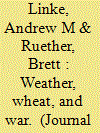

|
|
|
|
|
| Summary/Abstract |
We examine how Syria’s local growing seasons and precipitation variability affected patterns of violence during the country’s civil war (2011–19). Among Syria’s 272 subdistricts (nahiyah), we study conflict events initiated by the Assad regime or its allies, and, separately, by other armed non-government groups (‘rebels’). Throughout the war, violence to capture agriculture has been used regularly to control valuable cropland and harvests. Combatants also seek to deny their adversaries access to these resources by deploying violence to destroy agriculture. We test the hypothesis that conflict was most likely during local growing seasons due to both of these motivations. Additionally, we examine whether unusually dry conditions further elevated the risk of conflict during growing season months. A theory for why higher levels of conflict would occur during unusually dry conditions is that livelihood losses elevate incentives to control scarce crops and also facilitate recruitment of militants or their sympathizers. We find that violent events initiated by the government and rebel groups are both more likely during the growing season than other times of the year. There is also evidence that dry conditions during the growing season led to an increase in government-initiated attacks over the duration of the war. We find the strongest relationship between precipitation deficits and both government- and rebel-initiated violence in later years of the war. Compared with our growing season results, the rainfall deviation estimates are less consistent across models.
|
|
|
|
|
|
|
|
|
|
|
|
|
|
|
|
|
|
|
|
|